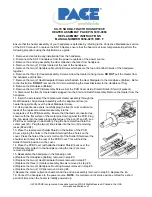
Attach the Lock-In
Lid Support
Connect the lid support to
the stud on the side of the kiln.
Tighten the lock nut until it is
snug.
Where to Locate Your Kiln
●
Place your kiln in a well-ventilated, covered, and
protected area such as the garage, basement, stor-
age building, utility or ceramic hobby room.
Caution:
The fumes from a kiln can corrode
metal and etch windows. If you are installing your
kiln in a living area such as the basement or in the
garage, it should be vented with a motorized vent.
●
Do NOT store gasoline, paint, or other flammable
liquids in the kiln room.
●
Never allow the room temperature of your firing
room to exceed 100 - 110°F. (Room temperature is
the temperature measured three or more feet away
from the kiln.) If necessary, use fans to lower room
temperature.
●
Never place the kiln near curtains or other combus-
tible materials such as art room supplies.
●
Position the kiln stand on a level surface that will not
be damaged by heat. We recommend a cement floor.
However, a sheet of protective material may be used
under the stand. Consult your hardware or building
supply store for a recommendation.
●
Avoid placing the kiln stand on rubber tile, linoleum
or any surface that might tend to mar or discolor
when heated.
●
Do not allow the kiln's power supply cord to contact
the side of the kiln. This could burn the cord.
Seating the Elements
Shipping may dislodge the elements of your kiln.
Please perform the kitchen knife test to make sure the el-
ements are seated in their grooves.
KITCHEN KNIFE TEST
Caution:
Always unplug the kiln before touching
an element with anything.
Caution:
Touch only a cold element never a hot
one with a plastic object such as a comb. Plastic
will melt on and ruin a hot element.
Press the elements
into their grooves by
running
a
blunt
kitchen knife, plastic
comb, or similar blunt
object completely
around each groove.
Do this before the first
firing, because it may
not be evident to the
eye whether the coil is in its groove.
Note:
Don't force the element into the groove
corners. If the element won't fit easily, lengthen it
with automotive snap-ring pliers. Stretch the
space between the coils just a little where the ele-
ment fits into the wall brick corners. It should
then easily seat into the corners.
If the element doesn't lie flat in the bottom of its
groove, you needn't be concerned as long as the element
fits all the way back into each corner and doesn't bulge
outside the groove. In fact, elements will not lie flat in
their terminal bricks (right behind switch box).
Cleaning the Kiln
Clean your kiln
before firing. Use a
soft brush nozzle on
a vacuum cleaner to
remove brick dust
from inside the kiln,
especially from the
grooves. A damp
cloth
or
damp
sponge may also be
used to gently wipe
dust from the side-
walls and brick bot-
tom. Clean the kiln
again whenever you notice dust inside.
Note:
Vacuum the kiln with a HEPA filtered vac-
uum cleaner or a central vacuum that takes the
dust outside.
THE ELECTRIC CIRCUIT
Circuit Breaker Panel
Install the kiln within 25' of the fuse or circuit breaker
panel. For every additional 50' from the panel, increase
circuit wire size by one gauge.
Circuit Wire
Trying to save money on the circuit installation by us-
ing a smaller diameter wire is not cost effective, because
the thinner wire generates more heat than the thicker
3
You can use a plastic vacuum nozzle, but
do not touch the firebricks with the
nozzle.

























